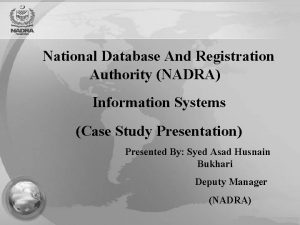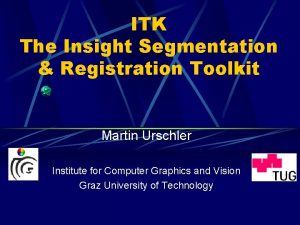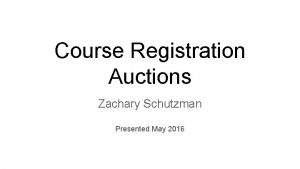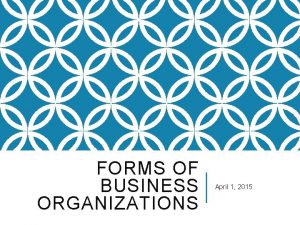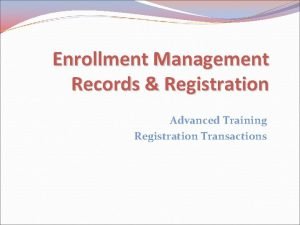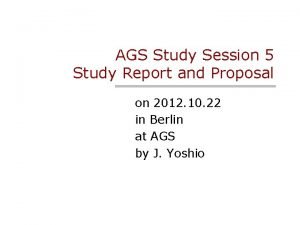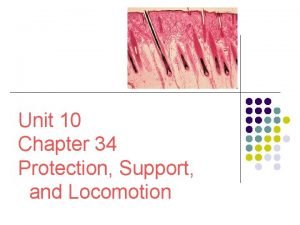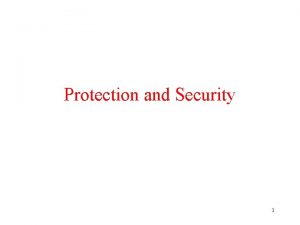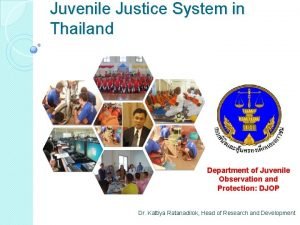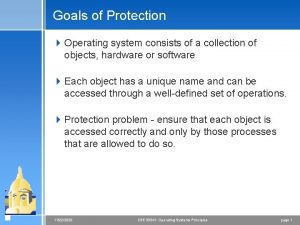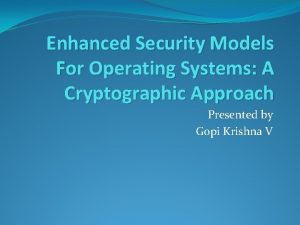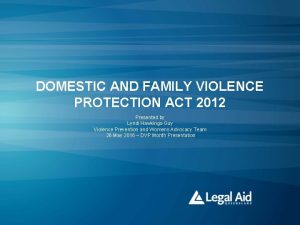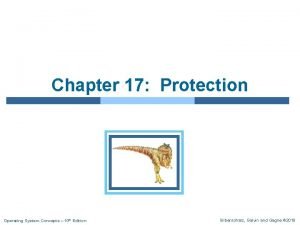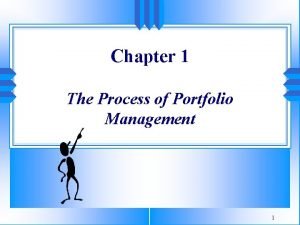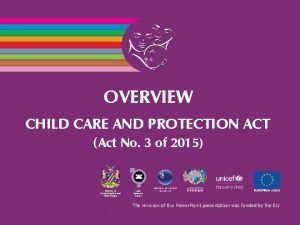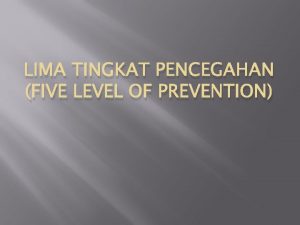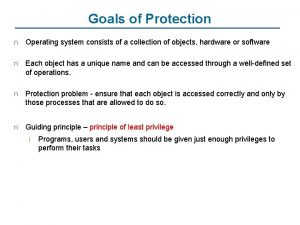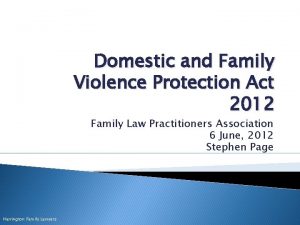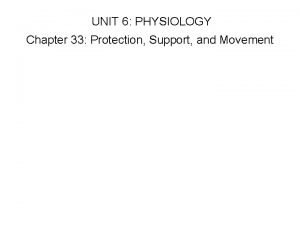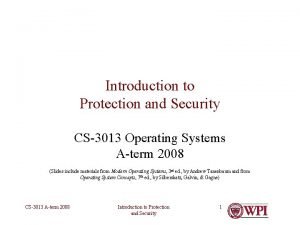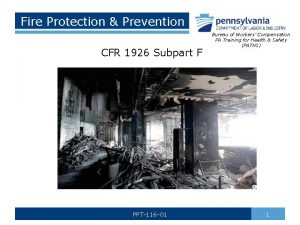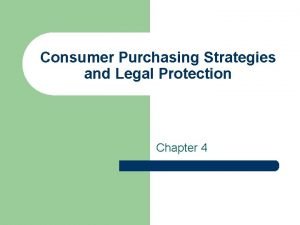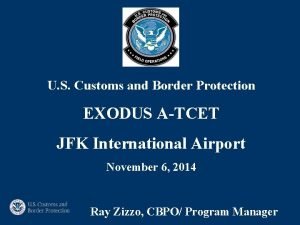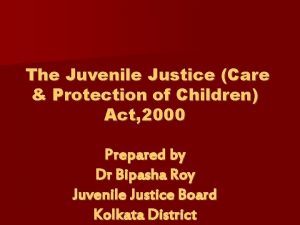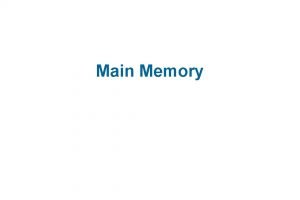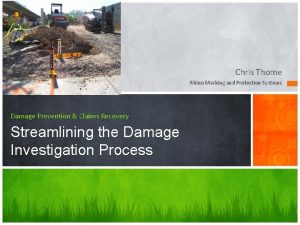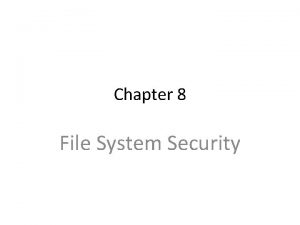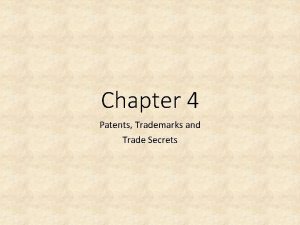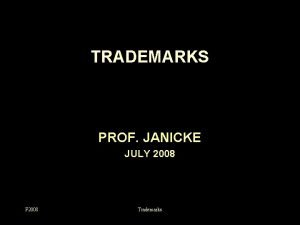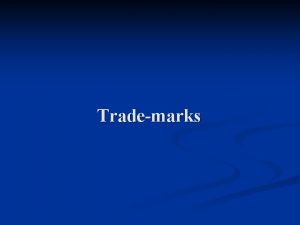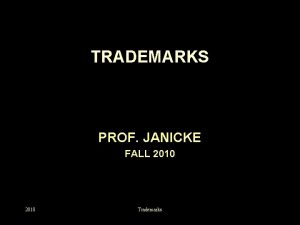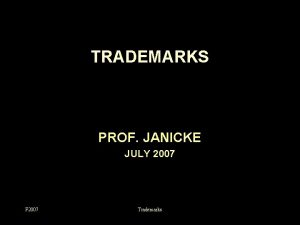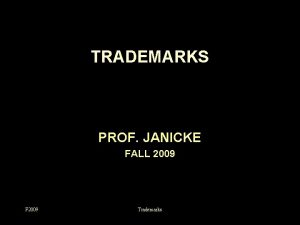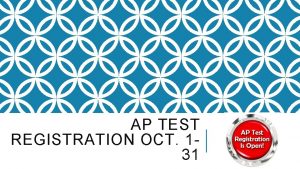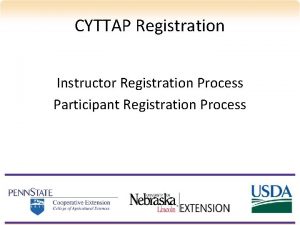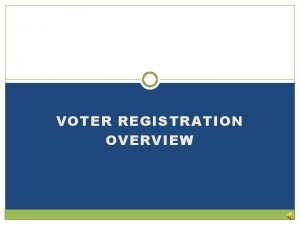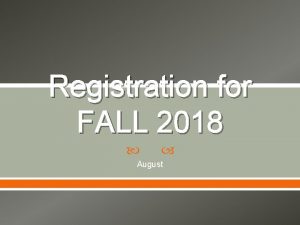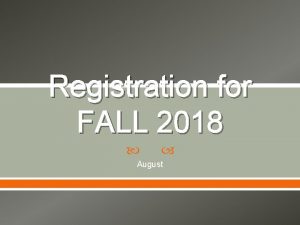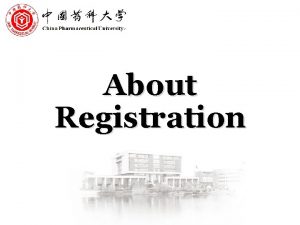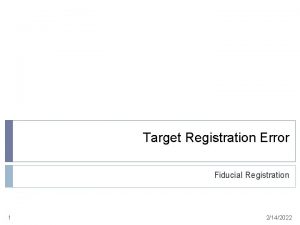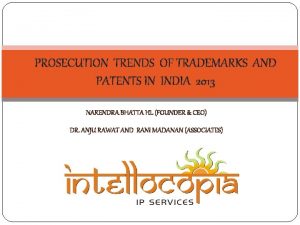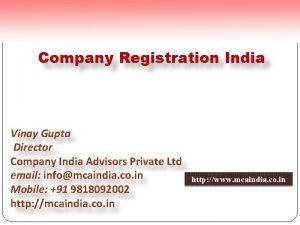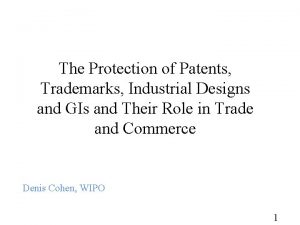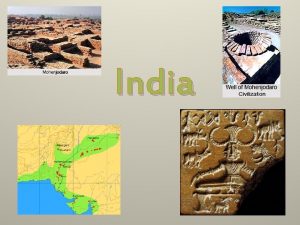REGISTRATION AND PROTECTION OF TRADEMARKS IN INDIA AND









































- Slides: 41

REGISTRATION AND PROTECTION OF TRADEMARKS IN INDIA AND ABROAD 1

‘Trade Mark’ – Definition under the Trade Marks Act 1999 Trade mark means, a mark capable of being represented graphically and which is capable of distinguishing the goods or services of one person from those of others and may include shape of goods, their packaging and combination of colures…. [S. 2 (1) (zb) Trade Marks Act 1999]

‘Mark’-Definition under the Trade Marks Act 1999 "mark" includes a device, brand, heading, label, ticket, name, signature, word, letter, numeral, shape of goods, packaging or combination of colours or any combination thereof; • [S. 2 (1) (m) Trade Marks Act 1999]

So in nutshell A Trade Mark is a mark, adopted for distinguishing, in the course of trade, the goods or services of one person from those of others; And it may be– Word – Device (picture, figure or geometrical design) – Label – Logo – Name – Signature – Letters – Numerals – 3 dimensional shapes, packaging of the Goods – Combination of Colours – Sound

Purpose & functions of a Trademark • To identify the origin of the product/service. • To distinguish the product/service of the proprietor from those of others. • To guarantee the quality of the product/service, and • To advertise the product/service.

Benefits of Registration of a trademark • Registration is prima facie evidence of proprietorship of the trademark • It gives the exclusive right to use the trademark in respect of goods/services; and to take legal action in case of infringement • The registered proprietor may assign or license the trademark as any other property • The registered proprietor can enjoy the Goodwill associated with registered trademark forever, if the mark is renewed from time to time

Registering the trademark in India • In case you want to register and protect your trademark within the territory of India, you must register it with the Registrar of trademarks in Indian Trade Marks Registry • The Controller General of Patents, Designs and Trade Marks is the Registrar of trademarks • The proprietorship over trademark can not be registered with Registrar of properties. 7

Administrative set up GOVERNMENT OF INDIA Department of Industrial Policy & Promotion, Ministry of Commerce & Industry Controller General of Patents, Designs & Trademarks (CGPDTM) Patents Ahmedabad Designs Delhi Trademarks Registry (TMR) Mumbai Geographical indications Chennai NIIPM Kolkata 8

Legal set up • The Trade Marks Registry was established under the Trade Marks Act 1940. • At present, it functions under the Trade Marks Act 1999 & The Trade Marks Rules 2002. These came into force on 15 th September 2003, replacing the Trade & Merchandise Marks Act 1958 and Trade & Merchandise Marks Rules 1959 • The Trade Marks (Amendment) Act 2010, has been passed and published in the official Gazette of the Government of India. • The Trade Marks Rules 2002 has been amended from time to time; and it is being replaced with the Trade Marks Rules 2016, the draft has already been published. 9

Technical set up of the TMR • All functions are performed through an web based Trade Marks System (TMS) • The Central Server of TMR is at Intellectual Property Office (IPO) Building in Delhi and back up server is at IPO, Mumbai. • All branches of the TMR are connected with the Central Server through the Virtual Private Network (VPN). • All the actions done by the office staff through the TMS is recorded in the Central Server on real time basis. 10

Steps for registration of trademark in India • Select a good trademark • Apply for registration on appropriate form with appropriate fee • Classify your goods & services and specify them properly • Apply before appropriate office of the Trade Marks Registry; and • Respond to office queries/notices properly and on time 11

Selecting a good Trademark Go for a trademark which is Easy to speak & spell (in case of word mark), Appealing and easy to remember or recollect. invented or coined word, unique monogram, logo or a geometrical device Don’t go for a trademark Which is not capable of distinguishing your goods or services from those of others- like one/two digit letters or numerals, common surnames/ names, words or pictures of the product concerned, etc. ……………. . [Section 9(1)(a)] Which refers to character or quality of goods/services concerned, which indicate geographical origin, which are common to trade, . . [Section 9(1) (b) & (c)] a deceptive, scandalous or offensive matter or a matter prohibited by law to be used as a trademark, …………………………………. [Sections 9(2)(3) & 13 ] a mark which is same/similar to an already existing trademark, …[Section 11]

Appropriate form and fee At present there are many forms prescribed for filing new applications depending on the nature of application such as Form TM-1, TM-2, TM-51, TM-52 TM-3, TM-8 etc. Fee ordinarily Rs. 4000/-per class [In the proposed revised rules there will be only one form for all types of applications for registration of trademarks. ]

Classification of goods and services For the purpose of registration of trademarks, the Registrar classifies goods & services in accordance with international classification of goods and services (NICE Classification) [S. 7 (1) of the Trade Marks Act 1999 and Rule 22 of the Trade Marks Rules 2002] Goods are classified in classes from 1 to 34, and services are classified in classes from 35 to 45 The classification of goods & services are published on the office website

Appropriate office of the TMR • Every application for registration of trademark is filed in the office of the Trade Marks Registry within whose territorial limits the principal place of business in India of the applicant is situate: Provided that where the applicant does not carry on business in India, the application shall be filed in the office of the Trade Marks Registry within whose territorial limits the place mentioned in the address for service in India as disclosed in the application, is situate. [Section 18(3) of the Trade Marks Act 1999] • The application can also be filed online but the appropriate office is still to be selected

Online filing of TM applications • Any person having Class III Digital Signature from (n)Code Solutions, TCS, Safe Scrypt & e- mudhra, may file TM applications and pay the fee through comprehensive e-filing services for trademarks, a gateway available on the office website. • Facility for online filing of more TM forms for online submission of Reply to Examination report is also available

Steps involved in registration process Receipt of applications, data entry & digitization [at Branch Offices] Examination of applications, approval by Supervisors, release of ERs [centrally at TMR Mumbai] In case of objections Response by applicant. Consideration of response [centralized] In case, there are no objections/objections waived Publication in the Trade Marks Journal • No opposition/opposition decided in favor of the applicant. Application proceeds to registration In case of opposition, opposition proceeding [at Branch office] Opposition allowedapplication refused Objections not waived after Response. Show Cause Hearing [at Branch Offices] Objections not waived. Application refused Appeal may be made before IPAB,

Protecting the Registration- by taking action in case of infringement of trademark I. Civil Suit • May not be instituted in a court inferior to the District Court. • Jurisdiction of the Court- where the plaintiff carries on business • [Section 134] Relief a) b) c) Injunction Damages or account of profit Delivery of the infringing goods and marks for distruction

Protecting the Registration- by taking action in case of infringement of trademark II. Criminal proceeding [Section 115] q infringement of trademark may be an offence under Section 103, 104 or 105 of the Trade Marks Act 1999 offences cognizable q search and seizure of infringing goods [Police Officer not below the rank of a DSP also may search and seize the infringing goods after obtaining the opinion of the Registrar] q Punishment to infringer

Registering the trademark abroad through Madrid System • The Madrid system provides one single procedure for the registration of trademarks in several territories. • It is governed by two treaties, ‘the Madrid Agreement concerning the international registration of marks’ (briefly known as Madrid Agreement) and the ‘Protocol relating to the Madrid Agreement’ (briefly known as Madrid Protocol). • These treaties are administered by the International Bureau (IB) of the World Intellectual Property Organisation (WIPO) in Geneva, Switzerland.

India’s accession to the Madrid Protocol • On April 8 th of 2013, the Hon’ble Minister of Commerce & Industry, the Government of India, deposited the instrument of accession to the Madrid Protocol, with the Director General of the WIPO. and accordingly, the provisions of international registration under the Madrid Protocol came into effect in India since July 8 th of 2013

Who can file application for international registration ? Any person (including a legal entity) • who is a citizen of, or is domiciled in, or has real and effective industrial or commercial establishment in a country which is member of the Madrid Protocol, and • who has got a registration of a trademark or who has filed an application for registration of trademark in that country can make application for international registration of trademarks under the Madrid Protocol. The application for international registration is made by the same person for the same trademark and in respect of goods or services covered in the domestic application or registration.

The brief procedure for international registration under the Madrid Protocol Office of Origin Applicant Files IA • Verifies & certifies IA • and sends it to IB, WIPO IB of the WIPO DCP 1 • Does formality examination, • If OK, registers publishes in WIPO gazette and sends to DCPs DCP 2 • Communicates Provisional refusal received from DCP to OO & applicant • Maintains portfolio DCP 3 §Designated contracting parties examine IRs as per their law §in case of objection/oppos ition communicate Provisional Refusal to WIPO and entertain the holders response §In case of no objection, give protection of the trademark as mark registered with their office

India, as an Office of Origin • A person (including a legal entity) o who is a citizen of India, or domiciled in India, or o who has a real and effective industrial or commercial establishment in India, and o who has got a registration of a trademark or whose application for registration of trademark is pending in Indian office , may make application for international registration of his trademark • Application must be filed only through the gateway for on line filing of International applications made available at the official website www. ipindia@nic. in, with handling fee of INR 2000/ • The Trade Marks Registry (TMR) verifies as to eligibility of the applicant and contents of the International Application vis-à-vis basic registration/application • When the International Application is not proper, the TMR sends a deficiency letter at the email of the applicant. The applicant shall prepare a reply to the deficiency letter and upload it, with supporting documents, if any, through the gateway.

• When the International Application is proper the TMR certifies and transmits such applications to the International Bureau of WIPO. • The fee for international application and the individual fee/Complementary fee for designated countries wherever applicable is to be paid directly to the International Bureau of the WIPO, in Swiss Francs • The IB of WIPO examines such applications formalities. • In case any irregularity (regarding classification of goods or services, for instance) is found, the IB communicates such irregularities to the TMR as well as to the applicant. The TMR also sends the irregularities to the applicant by email. The applicant has to rectify irregularities and prepare a reply to the irregularity letter, and upload it, with supporting document, if any, through the gateway. The TMR sends response to irregularities to the International Bureau of WIPO • If the International Application is found to be proper by the IB of the WIPO. It is registered with the IB, published in the WIPO gazette and transmitted to the offices of the designated Contracting Parties.

26

27

28

29

30

31

32

India, as an office of designated country • In case of an international applications designating India, is published as registered by WIPO and the same is notified to India, the particulars of international applications are recorded in TMR data base, by giving a national number to it as IRDI xxxxxx equating the date of international registration of IRDI with the date of application for a national application • The IRDI is examined as a national application as per provisions of the Trade Marks Act & Rules. • In case of any objection, a provisional refusal is communicated to WIPO. The WIPO communicates the provisional refusal to the applicant of the international application (the Holder of the international registration) • The Holder of the international registration, may respond to the provisional refusal and request this office to reconsider it only through an Indian agent. • In case of no objections, it is published in the Trade Marks Journal

• Any person may file notice of opposition to so published IRDI, as any other published national application. The Notice of Opposition should be filed on line through the gateway available at the website • On receiving any opposition to the IRDI, the TMR communicate s to the WIPO, a provisional refusal based on the opposition. The WIPO sends copy of the same to the holder. • The Holder of the international registration, may contest to provisional refusal and file a counter statement , only through an Indian agent. The opposition proceeding shall then be conducted as per usual process. • In case no opposition is received within the prescribed period and there has been no grounds for refusal, the TMR will notify the Grant of Protection of the international registration, to the WIPO.

35

36

Where are we under Madrid System? As on 31/03/2016 - • The WIPO has notified to Indian Office 23632 international registrations seeking protection of trademarks in India. The Indian office has to take decision about protection of respective trademarks in India as per our national law. • International registrations designating India are examined in order of the date of the international registrations and along with the national applications bearing the same date of applications. • The provisional refusals have been communicated to the WIPO in respect of 11600 marks and the Grant of protection has been communicated for 924 marks. • Indian office has received 385 applications for international registration of trademarks under the Madrid Protocol, out of which 362 applications have been certified and forwarded to the WIPO. Out of these applications 260 have been registered at the level of the WIPO and have been transmitted to offices of the designated contracting parties who will take final decision about protection of such marks.

Guidelines for functioning under the Madrid Protocol • A document tilted as ‘Guidelines for functioning under the Madrid Protocol’ is put up on the home page of official website of the CGPDTMwww. ipindia. nic. in

Attending to queries and problems • Queries and problems relating to the functioning of the Madrid Protocol in India may be sent to the International Registration wing of the TMR at madrid. tmr@nic. in • A telephone call for Queries or problems relating to the functioning of the Madrid Protocol may also be made at+91 22 24134555 +91 11 25300290

Guidelines for functioning under the Madrid Protocol • A document tilted as ‘Guidelines for functioning under the Madrid Protocol’ is put up on the home page of official website of the CGPDTMwww. ipindia. nic. in

Thanks for patient listening R. A. Tiwari Deputy Registrar of Trademarks & GI Office of the Controller General of Patents, Designs and Trademarks Trade Marks Registry Mumbai ra. tiwari@nic. in 41
 Nadra kiosk complaint
Nadra kiosk complaint Jnpt form 13 truck booking
Jnpt form 13 truck booking Louisiana victim notice and registration form
Louisiana victim notice and registration form Martin urschler
Martin urschler Kellogg bidding and registration
Kellogg bidding and registration Business ownership and registration vocabulary
Business ownership and registration vocabulary Utep records and registration
Utep records and registration Jnpt truck and driver registration
Jnpt truck and driver registration Protection support and locomotion answer key
Protection support and locomotion answer key Safeguarding and child protection the essentials
Safeguarding and child protection the essentials Difference between liner and varnish
Difference between liner and varnish Protection and security in operating system
Protection and security in operating system Protection of wounded, sick and shipwrecked
Protection of wounded, sick and shipwrecked Department of juvenile observation and protection
Department of juvenile observation and protection Goals and principles of protection in os
Goals and principles of protection in os Security and protection in operating system
Security and protection in operating system Domestic and family violence protection act 2012
Domestic and family violence protection act 2012 E commerce security and fraud protection
E commerce security and fraud protection E-commerce security and fraud protection
E-commerce security and fraud protection Security and protection in operating system
Security and protection in operating system Portfolio construction management and protection
Portfolio construction management and protection Pulp protection liners and bases
Pulp protection liners and bases 29cfr1910.132
29cfr1910.132 Children rights and responsibilities
Children rights and responsibilities National center for food protection and defense
National center for food protection and defense Lima level pencegahan
Lima level pencegahan Goals and principles of protection in os
Goals and principles of protection in os Domestic and family violence protection act 2012
Domestic and family violence protection act 2012 Chapter 33: protection, support, and movement answers
Chapter 33: protection, support, and movement answers Child protection and toy safety act
Child protection and toy safety act Protection and security in operating system
Protection and security in operating system Osha 1926 fire extinguisher
Osha 1926 fire extinguisher Consumer purchasing strategies and legal protection
Consumer purchasing strategies and legal protection Customs and border protection
Customs and border protection Care and protection of children act
Care and protection of children act Hardware address protection with base and limit registers
Hardware address protection with base and limit registers Customs and border protection
Customs and border protection General industry subpart for fire protection
General industry subpart for fire protection Handling information in health and social care
Handling information in health and social care Rhino marking and protection systems
Rhino marking and protection systems Child care and protection act 3 of 2015
Child care and protection act 3 of 2015 File protection and security
File protection and security
